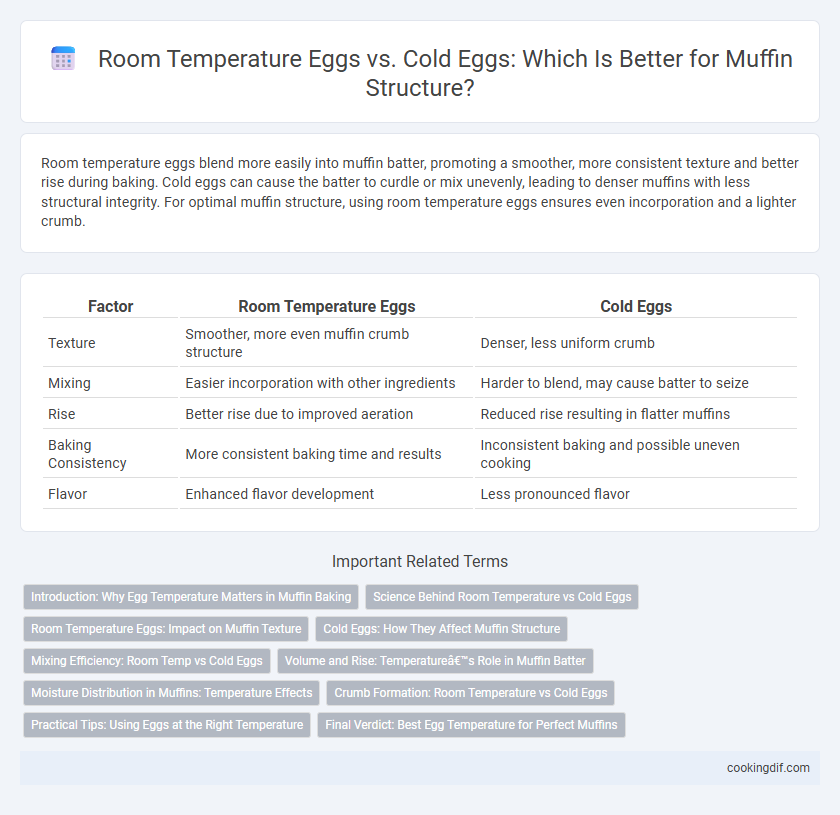Room temperature eggs blend more easily into muffin batter, promoting a smoother, more consistent texture and better rise during baking. Cold eggs can cause the batter to curdle or mix unevenly, leading to denser muffins with less structural integrity. For optimal muffin structure, using room temperature eggs ensures even incorporation and a lighter crumb.
Table of Comparison
| Factor | Room Temperature Eggs | Cold Eggs |
|---|---|---|
| Texture | Smoother, more even muffin crumb structure | Denser, less uniform crumb |
| Mixing | Easier incorporation with other ingredients | Harder to blend, may cause batter to seize |
| Rise | Better rise due to improved aeration | Reduced rise resulting in flatter muffins |
| Baking Consistency | More consistent baking time and results | Inconsistent baking and possible uneven cooking |
| Flavor | Enhanced flavor development | Less pronounced flavor |
Introduction: Why Egg Temperature Matters in Muffin Baking
Egg temperature significantly impacts muffin texture, as room temperature eggs blend more easily with batter, ensuring even moisture distribution and improved rise. Cold eggs can cause uneven mixing, resulting in dense, uneven crumb structures. Using room temperature eggs promotes optimal muffin volume and a tender, consistent crumb.
Science Behind Room Temperature vs Cold Eggs
Room temperature eggs incorporate more easily into batters, leading to better emulsification and a stable structure in muffins due to the reduced temperature differential, which allows fats to blend smoothly with other ingredients. Cold eggs can cause mixtures to curdle and resist proper air incorporation, negatively impacting muffin volume and crumb texture. Scientific studies show that warming eggs to ambient temperature enhances protein denaturation and coagulation during baking, promoting optimal rise and tender crumb formation.
Room Temperature Eggs: Impact on Muffin Texture
Using room temperature eggs in muffin recipes significantly improves the batter's ability to incorporate air, resulting in a lighter and fluffier texture. Eggs at room temperature blend more uniformly with other ingredients, promoting better emulsification and even crumb structure. Cold eggs can cause uneven mixing, leading to denser muffins with tougher texture.
Cold Eggs: How They Affect Muffin Structure
Cold eggs slow the incorporation of air during mixing, resulting in denser muffins with a tighter crumb structure. Their lower temperature causes the batter to remain colder longer, which can inhibit proper leavening agent activation and reduce muffin rise. Using cold eggs often yields muffins with a firmer texture and reduced volume compared to those made with room temperature eggs.
Mixing Efficiency: Room Temp vs Cold Eggs
Room temperature eggs blend more efficiently into batter, enhancing emulsification and resulting in a smoother, more stable muffin structure. Cold eggs can cause uneven mixing and lead to lumps, disrupting gluten development and producing a denser crumb. Optimal muffin texture relies on room temperature eggs to maximize aeration and mixing consistency.
Volume and Rise: Temperature’s Role in Muffin Batter
Room temperature eggs enhance muffin batter by promoting better volume and rise, as their temperature allows them to incorporate more air during mixing, resulting in a lighter, fluffier texture. Cold eggs, in contrast, can cause the batter to curdle or mix unevenly, hindering the development of structure and reducing the muffin's final height. Optimal muffin batter temperature, achieved with room temperature eggs, facilitates stronger gluten formation and efficient rising, crucial for achieving desirable volume and lightness.
Moisture Distribution in Muffins: Temperature Effects
Room temperature eggs enhance moisture distribution in muffins by allowing better emulsification with fats, resulting in a more uniform crumb structure. Cold eggs can cause uneven mixing and pockets of moisture, leading to dense or gummy textures. Temperature-controlled eggs optimize batter consistency, improving overall muffin tenderness and rise.
Crumb Formation: Room Temperature vs Cold Eggs
Room temperature eggs enhance crumb formation by promoting better emulsification and air incorporation, resulting in a tender, evenly textured muffin crumb. Cold eggs can cause uneven mixing, leading to denser, less uniform crumbs due to restricted fat and liquid integration. Optimal muffin structure relies on using room temperature eggs to ensure balanced moisture distribution and fine crumb development.
Practical Tips: Using Eggs at the Right Temperature
Room temperature eggs blend more effectively with batter, resulting in improved muffin rise and tender crumb structure compared to cold eggs, which can cause uneven mixing and dense texture. To achieve optimal muffin texture, remove eggs from the refrigerator 30 minutes before baking or place them in warm water for 5-10 minutes. Proper egg temperature ensures consistent emulsification and batter aeration, enhancing muffin volume and moistness.
Final Verdict: Best Egg Temperature for Perfect Muffins
Room temperature eggs enhance muffin structure by blending more evenly with batter, resulting in a lighter, more tender crumb compared to cold eggs that can cause uneven mixing and denser texture. Using room temperature eggs improves leavening agent activation, promoting better rise and fluffiness in muffins. For consistently perfect muffins, room temperature eggs are the best choice to achieve optimal texture and volume.
Room Temperature Eggs vs Cold Eggs for structure Infographic

 cookingdif.com
cookingdif.com